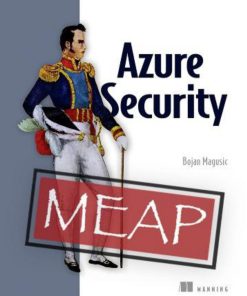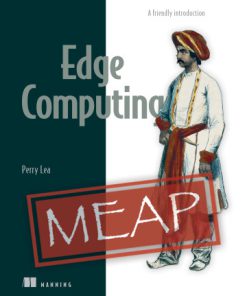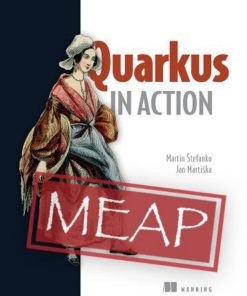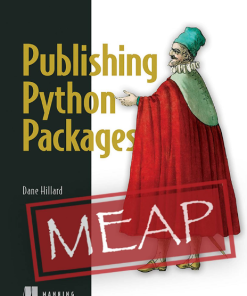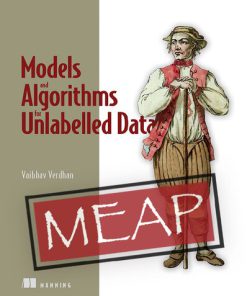Time Series Forecasting in Python MEAP v03 1st edition by Marco Peixeiro 9781638351474 1638351473
$50.00 Original price was: $50.00.$25.00Current price is: $25.00.
Time Series Forecasting in Python MEAP v03 1st edition by Marco Peixeiro – Ebook PDF Instant Download/Delivery:9781638351474, 1638351473
Full download Time Series Forecasting in Python MEAP v03 1st edition after payment
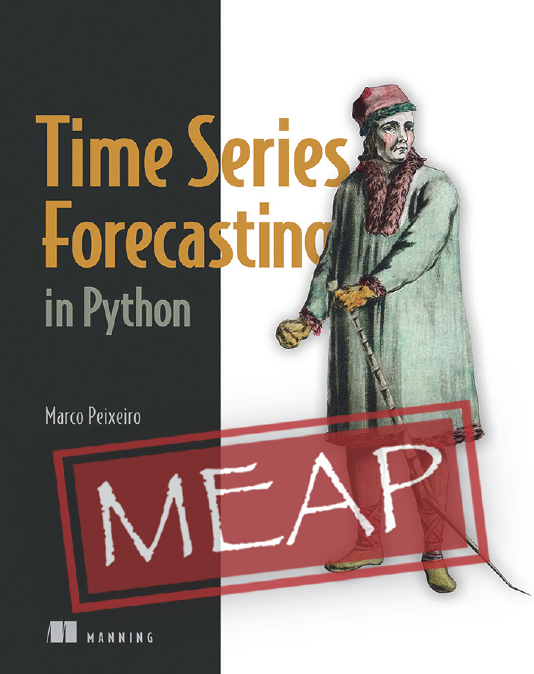
Product details:
ISBN 10: 1638351473
ISBN 13: 9781638351474
Author: Marco Peixeiro
Build predictive models from time-based patterns in your data. Master statistical models including new deep learning approaches for time series forecasting. In Time Series Forecasting in Python you will learn how to: Recognize a time series forecasting problem and build a performant predictive model Create univariate forecasting models that account for seasonal effects and external variables Build multivariate forecasting models to predict many time series at once Leverage large datasets by using deep learning for forecasting time series Automate the forecasting process Time Series Forecasting in Python teaches you to build powerful predictive models from time-based data. Every model you create is relevant, useful, and easy to implement with Python. You’ll explore interesting real-world datasets like Google’s daily stock price and economic data for the USA, quickly progressing from the basics to developing large-scale models that use deep learning tools like TensorFlow. About the technology You can predict the future—with a little help from Python, deep learning, and time series data! Time series forecasting is a technique for modeling time-centric data to identify upcoming events. New Python libraries and powerful deep learning tools make accurate time series forecasts easier than ever before. About the book Time Series Forecasting in Python teaches you how to get immediate, meaningful predictions from time-based data such as logs, customer analytics, and other event streams. In this accessible book, you’ll learn statistical and deep learning methods for time series forecasting, fully demonstrated with annotated Python code. Develop your skills with projects like predicting the future volume of drug prescriptions, and you’ll soon be ready to build your own accurate, insightful forecasts. What’s inside Create models for seasonal effects and external variables Multivariate forecasting models to predict multiple time series Deep learning for large datasets Automate the forecasting process About the reader For data scientists familiar with Python and TensorFlow. About the author Marco Peixeiro is a seasoned data science instructor who has worked as a data scientist for one of Canada’s largest banks
Time Series Forecasting in Python MEAP v03 1st Table of contents:
Part 1. Time waits for no one
-
Understanding time series forecasting
1.1 Introducing time series
1.1.1 Components of a time series
1.2 Bird’s-eye view of time series forecasting
1.2.1 Setting a goal
1.2.2 Determining what must be forecast to achieve your goal
1.2.3 Setting the horizon of the forecast
1.2.4 Gathering the data
1.2.5 Developing a forecasting model
1.2.6 Deploying to production
1.2.7 Monitoring
1.2.8 Collecting new data
1.3 How time series forecasting is different from other regression tasks
1.3.1 Time series have an order
1.3.2 Time series sometimes do not have features
1.4 Next steps
Summary -
A naive prediction of the future
2.1 Defining a baseline model
2.2 Forecasting the historical mean
2.2.1 Setup for baseline implementations
2.2.2 Implementing the historical mean baseline
2.3 Forecasting last year’s mean
2.4 Predicting using the last known value
2.5 Implementing the naive seasonal forecast
2.6 Next steps
Summary -
Going on a random walk
3.1 The random walk process
3.1.1 Simulating a random walk process
3.2 Identifying a random walk
3.2.1 Stationarity
3.2.2 Testing for stationarity
3.2.3 The autocorrelation function
3.2.4 Putting it all together
3.2.5 Is GOOGL a random walk?
3.3 Forecasting a random walk
3.3.1 Forecasting on a long horizon
3.3.2 Forecasting the next timestep
3.4 Next steps
3.5 Exercises
3.5.1 Simulate and forecast a random walk
3.5.2 Forecast the daily closing price of GOOGL
3.5.3 Forecast the daily closing price of a stock of your choice
Summary
Part 2. Forecasting with statistical models
- Modeling a moving average process
4.1 Defining a moving average process
4.1.1 Identifying the order of a moving average process
4.2 Forecasting a moving average process
4.3 Next steps
4.4 Exercises
4.4.1 Simulate an MA(2) process and make forecasts
People also search for Time Series Forecasting in Python MEAP v03 1st :
time series forecasting python machine learning
time series forecasting pyspark
time series model forecasting python
applied time series analysis and forecasting with python pdf
Tags:
Marco Peixeiro,Time Series,Forecasting
You may also like…
Computers - Security
Azure Security MEAP V03 1st Edition by Bojan Magusic ISBN 9781633438811 1633438813
Computers - Computer Science
Edge Computing (MEAP V03) by Perry Lea 163343849X 9781633438491
Computers - Artificial Intelligence (AI)
Computers - Enterprise Computing Systems
Computers - Programming
Mathematics - Mathematical Statistics
Recent Advances in Time Series Forecasting 1st Edition Taylor & Francis Group
Computers - Programming
Publishing Python Packages (MEAP V03) by Dane Hillard 9781638351689 1638351686
Computers - Databases
Models and Algorithms for Unlabelled Data (MEAP v03) 1 / MEAP v03 Edition Vaibhav Verdhan



